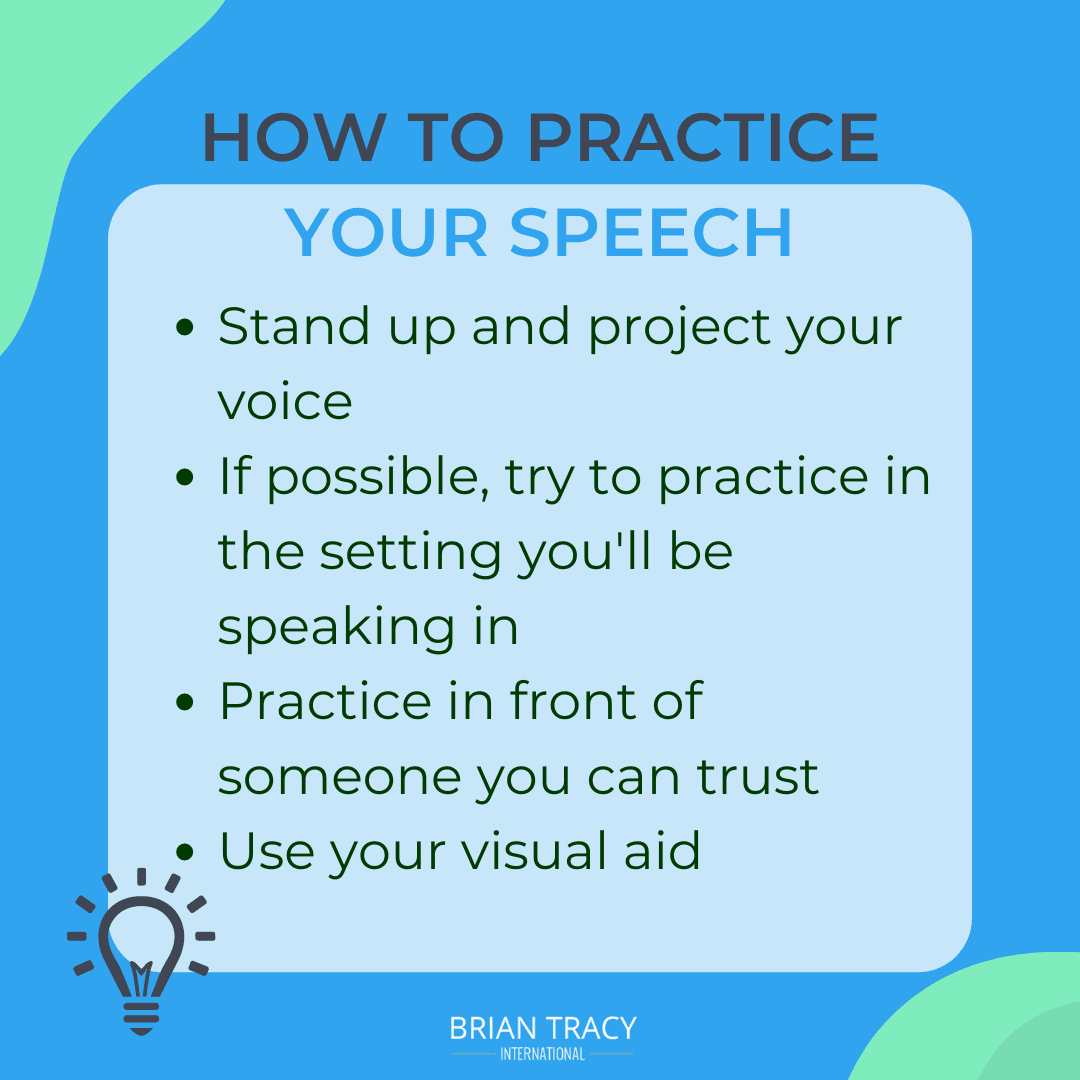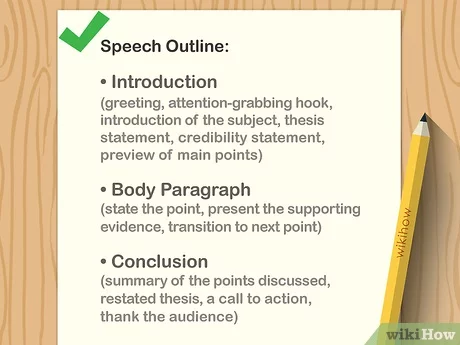How to Create a Speech?
To create a speech, start by identifying your main message and target audience. Then, outline your speech by organizing your ideas into a logical structure and adding supporting evidence.
Write a succinct introduction that grabs the audience’s attention, followed by body paragraphs that expand on your main points. Use clear and concise language, and include transitions to smoothly guide your listeners. Finally, conclude your speech with a strong and impactful ending that summarizes your key points and leaves a lasting impression.
By following these steps, you can create a compelling and effective speech.

Credit: www.briantracy.com
Understanding The Audience
When it comes to delivering a successful speech, one of the most crucial aspects is understanding your audience. The ability to connect with and engage your audience can make or break your speech. Without a clear understanding of who you are speaking to, it can be challenging to deliver a message that resonates and captures their attention. In this section, we will explore the importance of understanding your audience, focusing on three key areas: demographics, interests, and knowledge.
Demographics
Before crafting your speech, it is essential to gather information about the demographics of your audience. This includes their age, gender, location, educational background, and occupation. By understanding these demographic factors, you can tailor your speech to ensure it is relatable and relevant. For example, if you are speaking to a group of young professionals, you may want to incorporate modern references and speak to their career aspirations. On the other hand, if your audience consists of retirees, you may want to focus on topics that are of interest and relevance to them.
Interests And Knowledge
In addition to demographics, it is crucial to consider the interests and knowledge of your audience. Take the time to research their hobbies, passions, and areas of expertise. This insight will enable you to incorporate examples, stories, and analogies that resonate with their interests. By tapping into their existing knowledge on a subject, you can build a connection and establish credibility. For instance, if you are delivering a speech on environmental sustainability to an audience of nature enthusiasts, you can share specific examples of how their actions can make a positive impact.
| Key Points | Benefits |
|---|---|
| Research audience demographics | Customize speech to be relevant and relatable |
| Discover audience interests and knowledge | Create a connection and establish credibility |
| Use examples and analogies | Make complex topics understandable and relatable |
In conclusion, understanding your audience is essential for creating a speech that captivates and resonates with them. By considering their demographics, interests, and knowledge, you can tailor your speech to be relatable, relevant, and engaging. Taking the time to research and understand your audience will allow you to deliver a speech that leaves a lasting impact.

Credit: www.write-out-loud.com
Defining The Purpose
When creating a speech, it is essential to start by defining the purpose of your message. The purpose serves as the foundation on which your speech is built, guiding you in selecting the appropriate content and delivery style. Whether you aim to inform, persuade, or entertain your audience, understanding the purpose will help you shape your speech effectively.
Informative Speech
An informative speech is designed to provide the audience with new knowledge, insights, or educative content. The goal is to present factual information in a clear and concise manner, enabling the listeners to gain a deeper understanding of the topic at hand. When crafting an informative speech, it is crucial to conduct thorough research and organize your ideas logically.
- Choose a topic that is interesting and relevant to your audience.
- Gather reliable and up-to-date information from credible sources.
- Organize your speech using a clear and logical structure such as chronological, spatial, or topical.
- Use visual aids, examples, and real-life stories to enhance understanding.
- Summarize key points and conclude with a memorable takeaway.
Persuasive Speech
A persuasive speech aims to convince the audience to adopt a specific viewpoint, take action, or change their beliefs. It requires capturing the audience’s attention, building credibility, and presenting compelling arguments that appeal to their emotions and rationality. When crafting a persuasive speech, it is essential to consider your target audience and tailor your message accordingly.
- Identify the issue or topic that you want to persuade your audience about.
- Evoke emotions and create a strong connection with your audience.
- Support your arguments with credible evidence, statistics, and expert opinions.
- Anticipate and address counterarguments to strengthen your position.
- Use persuasive language, storytelling techniques, and rhetorical devices to engage your audience.
Entertaining Speech
An entertaining speech is designed to captivate and amuse the audience, providing them with an enjoyable experience. The primary goal is to entertain and leave a positive impression on the listeners. When creating an entertaining speech, it is crucial to incorporate humor, storytelling, and engaging delivery techniques.
| To create an entertaining speech: |
|---|
| Choose a topic that is light-hearted and appeals to the audience’s interests. |
| Use storytelling techniques and personal anecdotes to engage the audience. |
| Incorporate humor, wit, and comedic timing to evoke laughter. |
| Utilize props, visual aids, or multimedia to enhance the entertainment value. |
| Practice and perfect your delivery to maintain audience engagement throughout. |
Structuring The Speech
Learn how to structure your speech effectively with these 6 guidelines. Craft concise sentences, avoid repetition, and engage your audience by starting each paragraph with a variety of phrases. Keep it SEO friendly and easy to understand.
Introduction
Structuring your speech is a crucial step in creating a memorable and impactful presentation. A well-organized speech not only helps you convey your message clearly, but it also keeps your audience engaged throughout. In this article, we will explore the three essential components of speech structure: the introduction, body, and conclusion.
Body
The body of your speech is where you develop your main points and support them with relevant information and examples. To ensure coherence, consider organizing your ideas using a logical structure such as:
| Structure | Description |
|---|---|
| Chronological | Present your points in the order of events or steps. |
| Cause and Effect | Show the relationship between causes and their effects. |
| Problem and Solution | Explain a problem and propose a solution. |
| Compare and Contrast | Highlight similarities and differences between two or more subjects. |
| Topical | Discuss each point separately, addressing their significance. |
Within each main point, use subpoints to provide further details or evidence. Consider using bullet points or numbered lists to make your ideas more visually appealing and easily digestible for your audience. Remember to keep your sentences concise and well-structured to maintain clarity and comprehension.
Conclusion
The conclusion is your final opportunity to leave a lasting impression on your audience. Aim to summarize your main points succinctly and restate your thesis or key message. Consider using a memorable quote or powerful statement to leave your audience with a thought-provoking idea. Keep in mind that your conclusion should be precise and impactful, leaving your audience with a clear takeaway from your speech.

Credit: www.wikihow.com
Delivery And Rehearsal
Discover the secrets of creating a captivating speech through effective delivery and rehearsal techniques. Gain confidence and engage your audience by following these invaluable tips for crafting an impactful presentation.
Body Language
When it comes to delivering a speech, your body language plays a vital role in conveying your message effectively. The way you stand, move, and gesture can either enhance or distract from your words. Maintaining an open posture with relaxed shoulders and facing the audience directly can help you appear confident and engaged. Avoid crossing your arms or fidgeting, as these actions can give off a negative impression. Instead, use hand gestures purposefully to emphasize key points and maintain eye contact with your audience, making them feel more connected to your message.Tone And Voice
The tone and voice you use while delivering your speech can greatly impact how your message is received. It’s important to strike the right balance between being enthusiastic and maintaining a professional demeanor. Speak with clarity and project your voice to ensure everyone in the room can hear you clearly. Varying your pitch and volume throughout the speech can help maintain your audience’s attention and add emphasis to important points. Remember to speak at a pace that is comfortable for both you and your listeners, allowing them to absorb and process the information you’re sharing.Practice
Practice is key to delivering a successful speech. By rehearsing your speech beforehand, you become more familiar with the content, allowing you to speak more confidently and naturally. While practicing, pay attention to the flow and structure of your speech, ensuring that your ideas are presented in a logical and coherent manner. It’s a good idea to record yourself during practice sessions and listen back to identify areas where you can improve. Additionally, consider seeking feedback from trusted individuals who can provide constructive criticism and suggestions for improvement. In conclusion, by focusing on your body language, tone, and voice, as well as dedicating time to practice, you can create a speech that is engaging and impactful. Remember to be confident in your delivery and use these techniques to effectively connect with your audience and deliver your message with clarity.Frequently Asked Questions On How To Create A Speech?
How Do You Start Making A Speech?
To start making a speech, follow these steps: 1. Begin with a strong opening sentence that grabs attention. 2. Clearly state the purpose and main points of your speech. 3. Use personal anecdotes or relatable stories that connect with the audience.
4. Use visual aids or props to enhance your message. 5. Practice and rehearse your speech to build confidence and ensure smooth delivery.
How Do I Write My Own Speech?
To write your own speech, follow these guidelines: Keep sentences under 20 words, write in an SEO friendly, unique and plagiarism-free manner, use active voice and ensure easy comprehension. Avoid starting sentences with specific words and phrases, and prioritize writing in an engaging human-like style.
Your speech should be within 50 words.
How Do I Develop My Speech?
To develop your speech, follow these steps: 1. Research and organize your topic. 2. Practice speaking regularly, in front of a mirror or with friends. 3. Focus on your body language and vocal tone. 4. Use visual aids and props to enhance your message.
5. Seek feedback and keep improving. Remember, consistent practice and preparation are key.
What Are The 7 Steps To Writing A Speech?
The 7 steps to writing a speech include: 1. Determine the purpose and topic of your speech. 2. Research and gather relevant information. 3. Create an outline to organize your speech. 4. Write an attention-grabbing introduction. 5. Develop the main points and supporting details.
6. Craft a compelling conclusion. 7. Practice and rehearse your speech for delivery.
How Can I Write A Compelling Speech?
To write a compelling speech, consider your audience, use personal anecdotes, provide evidence, and incorporate emotional appeals.
Conclusion
Crafting a compelling speech is a skill that can greatly impact your ability to communicate effectively. By following the steps outlined in this blog post, you can create a speech that captures your audience’s attention, conveys your message clearly, and leaves a lasting impression.
Remember to define your purpose, structure your speech, engage your audience, and practice your delivery. With these tools, you can confidently stand before any audience and deliver a memorable and impactful speech. So, seize the opportunity to become a confident and influential speaker today!



